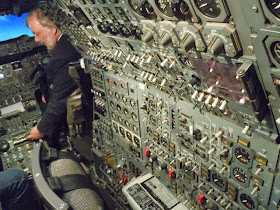Last Wednesday eighteen members of Hazel Grove Rotary Group and some friends came to the Runway Visitor Park at Manchester Airport for a full technical tour of Concorde. The group was led by a friend of mine, John, who is a volunteer guard on the Churnet Valley Railway.
Concorde G-BOAC in her hangar at the Runway Visitor Park. The restaurant is on the left side of the hangar and has changed hands since this picture was taken.
All day parking is included in a tour so many came early and enjoyed a coffee and lunch in our restaurant. Their afternoon with me started at 14:00 in our 'Avro Suit' where I welcomed them with an introduction and the showing of a short video about the aeroplane. From here we went into Alpha Charlie's hangar for a first sight of the magnificent white bird.
I introduced this impressive aeroplane to the group, and we spent about forty minutes walking around her looking at the features that make Concorde the special aeroplane that she is. Some aspects of this section of the tour, such as that fabulous wing with an enormous speed range with no high-lift devices and its vortex lift below 300 knots, and the engine air intakes with the engines always in a subsonic environment and pressure recovery in the intake supplying over 70% of the forward thrust at Mach 2 supercruise, can be challenging to explain to a lay audience. However, feedback in the pub afterwards indicates I had probably pitched it about right!
I introduced this impressive aeroplane to the group, and we spent about forty minutes walking around her looking at the features that make Concorde the special aeroplane that she is. Some aspects of this section of the tour, such as that fabulous wing with an enormous speed range with no high-lift devices and its vortex lift below 300 knots, and the engine air intakes with the engines always in a subsonic environment and pressure recovery in the intake supplying over 70% of the forward thrust at Mach 2 supercruise, can be challenging to explain to a lay audience. However, feedback in the pub afterwards indicates I had probably pitched it about right!
Inside the Concorde hangar
My colleague Ross joined us as we went on board the aeroplane. Our visitors settled themselves into the comfortable dark blue leather seats in the forward cabin where Ross talked about Concorde's history, time in service with British Airways and Air France, reasons for retirement to the museums, and entertained them with supersonic anecdotes.
I settled down in the cockpit to where the visitors came forward in groups of four at a time for me to explain how the aeroplane was flown. Concorde pre-dates today's 'automatic' computer controlled airliners where the aeroplane is 'operated' by the flight crew rather than 'flown'. Concorde, with her analogue-instrumented 1970s flight deck with not a computer screen in sight, was very much 'flown' rather than 'operated'.
The dark blue leather Terence Conran designed seats in Concorde's forward cabin. Concorde was a 'one class' aeroplane (Concorde class!) with 100 passenger seats in two cabins.
I settled down in the cockpit to where the visitors came forward in groups of four at a time for me to explain how the aeroplane was flown. Concorde pre-dates today's 'automatic' computer controlled airliners where the aeroplane is 'operated' by the flight crew rather than 'flown'. Concorde, with her analogue-instrumented 1970s flight deck with not a computer screen in sight, was very much 'flown' rather than 'operated'.
CVR volunteers Kevin (crossing keeper and whipper-in for the volunteer roster) and me (Consall signalman) in AC's cockpit
Our tour lasted over two hours, finishing with the handing out of an individually-named 'Concorde Certificate' to each visitor. The group kindly invited me to join them afterwards at the nearby 'Romper Inn' for a meal. Over dinner, Concorde and various other conversations continued and it was obvious that everyone had thoroughly enjoyed their afternoon. As this tour had been my fifth and final one that day, a pint of 'Tatton' bitter was most welcome to 'wet the whistle' after all that talking.
It's always good to do a tour with a group of lively and interested visitors, and John's Rotary Group had certainly been that. An enjoyable end to a busy day!
.















